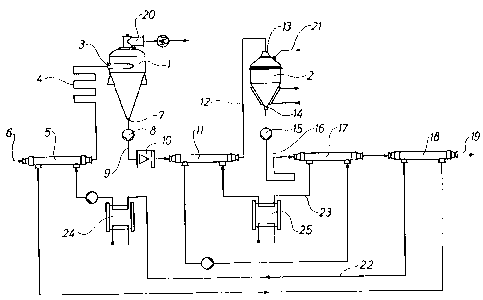Some of the information on this Web page has been provided by external sources. The Government of Canada is not responsible for the accuracy, reliability or currency of the information supplied by external sources. Users wishing to rely upon this information should consult directly with the source of the information. Content provided by external sources is not subject to official languages, privacy and accessibility requirements.
Any discrepancies in the text and image of the Claims and Abstract are due to differing posting times. Text of the Claims and Abstract are posted:
| (12) Patent: | (11) CA 2204613 |
|---|---|
| (54) English Title: | A PLANT FOR CONTINUOUSLY STERILISING FLUIDS, SUCH AS MILK AND CREAM |
| (54) French Title: | INSTALLATION DE STERILISATION CONTINUE DE FLUIDES TELS QUE LE LAIT ET LA CREME |
| Status: | Expired and beyond the Period of Reversal |
| (51) International Patent Classification (IPC): |
|
|---|---|
| (72) Inventors : |
|
| (73) Owners : |
|
| (71) Applicants : |
|
| (74) Agent: | MACRAE & CO. |
| (74) Associate agent: | |
| (45) Issued: | 2006-08-15 |
| (86) PCT Filing Date: | 1995-11-14 |
| (87) Open to Public Inspection: | 1996-05-30 |
| Examination requested: | 2002-06-05 |
| Availability of licence: | N/A |
| Dedicated to the Public: | N/A |
| (25) Language of filing: | English |
| Patent Cooperation Treaty (PCT): | Yes |
|---|---|
| (86) PCT Filing Number: | PCT/DK1995/000453 |
| (87) International Publication Number: | WO 1996015677 |
| (85) National Entry: | 1997-05-06 |
| (30) Application Priority Data: | ||||||
|---|---|---|---|---|---|---|
|
A plant for continuously sterilising fluids, such as milk and cream, comprises
a sterilising device (2) in which the fluid is sterilised
while steam is fed thereto, and a vacuum chamber (1) for removal of the water
from the fluid and from which the fluid is extracted by
means of a pump (8). The vacuum chamber (1) is accommodated before the
sterilising device (2) when seen in the flow direction of the
fluid, said vacuum chamber (1) being connected to said sterilising device (2)
through a first heat exchanger (11) for heating the fluid before
it enters said sterilising device (2).
Une installation de stérilisation continue de fluides tels que du lait ou de la crème comprend un dispositif de stérilisation (2) dans lequel le fluide est stérilisé pendant que de la vapeur est envoyée à l'intérieur de celui-ci, ainsi qu'une chambre à vide (1) conçue pour enlever l'eau du fluide et de laquelle le fluide est extrait au moyen d'une pompe (8). La chambre à vide (1) est disposée en amont du dispositif de stérilisation (2) par rapport au sens d'écoulement du fluide et est reliée audit dispositif de stérilisation (2) par un premier échangeur de chaleur (11) destiné à chauffer le fluide avant qu'il pénètre dans ledit dispositif de stérilisation (2).
Note: Claims are shown in the official language in which they were submitted.
Note: Descriptions are shown in the official language in which they were submitted.

2024-08-01:As part of the Next Generation Patents (NGP) transition, the Canadian Patents Database (CPD) now contains a more detailed Event History, which replicates the Event Log of our new back-office solution.
Please note that "Inactive:" events refers to events no longer in use in our new back-office solution.
For a clearer understanding of the status of the application/patent presented on this page, the site Disclaimer , as well as the definitions for Patent , Event History , Maintenance Fee and Payment History should be consulted.
| Description | Date |
|---|---|
| Time Limit for Reversal Expired | 2010-11-15 |
| Letter Sent | 2009-11-16 |
| Inactive: Office letter | 2007-11-02 |
| Letter Sent | 2006-08-24 |
| Letter Sent | 2006-08-24 |
| Letter Sent | 2006-08-24 |
| Letter Sent | 2006-08-24 |
| Letter Sent | 2006-08-21 |
| Letter Sent | 2006-08-21 |
| Grant by Issuance | 2006-08-15 |
| Inactive: Cover page published | 2006-08-14 |
| Inactive: Correspondence - Transfer | 2006-07-06 |
| Inactive: Multiple transfers | 2006-06-12 |
| Pre-grant | 2006-05-31 |
| Inactive: Final fee received | 2006-05-31 |
| Notice of Allowance is Issued | 2005-12-15 |
| Letter Sent | 2005-12-15 |
| Notice of Allowance is Issued | 2005-12-15 |
| Inactive: Approved for allowance (AFA) | 2005-09-13 |
| Amendment Received - Voluntary Amendment | 2005-07-21 |
| Inactive: S.30(2) Rules - Examiner requisition | 2005-02-18 |
| Letter Sent | 2004-07-27 |
| Letter Sent | 2004-04-28 |
| Amendment Received - Voluntary Amendment | 2003-02-12 |
| Letter Sent | 2002-07-24 |
| All Requirements for Examination Determined Compliant | 2002-06-05 |
| Request for Examination Requirements Determined Compliant | 2002-06-05 |
| Request for Examination Received | 2002-06-05 |
| Letter Sent | 2000-05-12 |
| Reinstatement Requirements Deemed Compliant for All Abandonment Reasons | 2000-05-03 |
| Deemed Abandoned - Failure to Respond to Maintenance Fee Notice | 1999-11-15 |
| Letter Sent | 1997-10-23 |
| Inactive: IPC assigned | 1997-08-13 |
| Inactive: First IPC assigned | 1997-08-13 |
| Inactive: Notice - National entry - No RFE | 1997-08-05 |
| Inactive: Single transfer | 1997-07-28 |
| Application Published (Open to Public Inspection) | 1996-05-30 |
| Abandonment Date | Reason | Reinstatement Date |
|---|---|---|
| 1999-11-15 |
The last payment was received on 2005-10-21
Note : If the full payment has not been received on or before the date indicated, a further fee may be required which may be one of the following
Please refer to the CIPO Patent Fees web page to see all current fee amounts.
Note: Records showing the ownership history in alphabetical order.
| Current Owners on Record |
|---|
| INVENSYS APV A/S |
| Past Owners on Record |
|---|
| JENS ANDERS JENSEN |